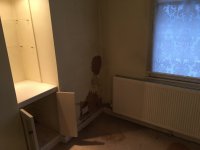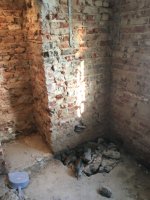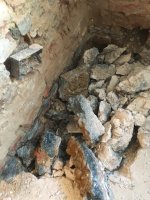I've had a full damp and timber survey done, watched hundreds of hours of youtube damp videos, spoken with a tonne of different trades and the only thing I am sure of is that everyone has a different opinion. Thought I would ask on here as I have had excellent responses to another question.
What is the most likely cause of damp in this picture? What steps would you take to resolve it?

The facts:
What is the most likely cause of damp in this picture? What steps would you take to resolve it?
The facts:
- The house was built in 1810, is a listed building and has no DPC
- This is an internal wall, behind this wall is a bathroom which has a floor level about 8cm higher than the floor level in this room
- The floor would have originally been clay tiles, has since had a concrete slab laid
- The area in the photo was behind some kitchen units, the oak floor had buckled considerably
- The slab appears relatively dry, not damp to the touch
- The house is of solid wall construction without a cavity
- The room has been plastered at some point over the last 20 years with gypsum and painted with what appears to be a damp seal paint




